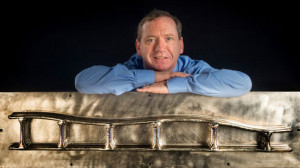Research at Cranfield University conducted in collaboration with BAE Systems has resulted in the production of a large scale, 3D printed metal part. The part, measuring 1.2 metres, is thought to be one of the biggest 3D printed parts produced in the UK in a single operation using metal additive technologies.
According to the researchers at Cranfield undertaking the build, this part — a spar section— was designed by BAE Systems engineers, and constructed from titanium utilizing Cranfield’s proprietary Wire+Arc Additive Manufacture (WAAM) process. Spar sections are critical structural parts within an aircraft wing, and using the WAAM process, this metal prototype took just 37 hours to construct, direct from a digital model. By comparison, using traditional manufacturing methods, the same part would typically take weeks.
The time saving element of using 3D printing is a huge driver in the research to directly manufacture large structural parts for aircraft manufacturers. That, together with significant direct and indirect cost savings.

Obviously, there will need to be a ton of testing and qualification before this part makes it anywhere near a flying plane, but with the number of global research organizations, working with industrial partners, the developments within aerospace for widening the scope for directly manufacturing parts, including critical components, are certainly gathering pace.
The WAAM process has been around for a while, its USP being the Wire+Arc element, but it is not a commercial process. However, recent developments to utilise the process for industrial applications have seen a multi-project, multi-client programme put in place by Cranfield. The programme is called WAAMMat, and it is aimed at maturing the technology so that it can be exploited across industry sectors.


